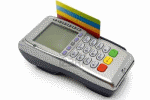
With businesses in every possible kind of industry from publishing to formalwear taking to the streets like never before, the pressure to have wireless point-of-sale technology available is greater than ever before. Ten years ago, only large corporations with nigh bottomless discretionary accounts could afford wireless POS systems. With the advent of ever-cheaper wireless technology in all fields, the game is changing to a point where even small to medium-sized businesses can expand into mobile purchasing and on the spot payment processing. The biggest hurdle is, and always has been, the wireless POS system cost.
How Does It Work?
Wireless point-of-sale systems work in much the same way as any other data transfer system. The only real difference is that these systems have to comply with federal financial security regulations, which means that any transaction processed this way has to be heavily encrypted to prevent misuse or theft of a customer's credit card information. When a customer swipes their card to make a purchase, the system reads the card and deducts the purchase amount from the holder's account. This amount is then transferred into the user's merchant or personal bank account, depending on which company the merchant is using and how their payment system is set up. Wireless POS system prices are predicated on items such as flexibility, newness of the technology, how well the technology adheres to government privacy standards, and so on.
What Are The Benefits?
Many merchants are finding that in this new, mobile age, being tied to a traditional brick and mortar storefront is less convenient than it used to be. The advent of companies like Amazon and Zappos make Internet shopping, purchasing, and shipping to and from just about anywhere as simple as pushing a few buttons. Fewer people are carrying cash all the time, because paper money is too easy to lose or steal. Cards offer more protection for a buyer's funds. Although this is advantageous for the buyer, in the past this created problems for merchants attempting to conduct business away from a traditional storefront. All too often, inability to accept credit cards at remote locations meant lost sales and revenue.
The wireless point-of-sale systems available currently eliminate that problem. Because these systems effectively give a merchant a portable, plastic-only pocket cash register, buying and selling anywhere there's a WiFi signal is as simple as swiping a card. This gives the merchant confidence that the funds will be in the merchant's account quickly and the customer confidence that their private information will remain secure. This can greatly reduce overhead, boost consumer spending, and result in higher profits for any business.
The Bottom Line
With mobile credit card processing platforms like Square very much in the public eye, many merchants might be tempted to use this as a "one size fits all" solution. The commercials do say they're free, and Square's website bears this out. However, the thing to remember about these credit card readers is that they charge a percentage on every transaction in lieu of monthly or annual fees. In Square's case, that percentage is 2.75 percent. While this doesn't sound like much, when that's being taken out of every transaction, whether it's ten dollars or ten thousand dollars, that adds up to a lot of money very quickly.
Wireless POS system cost typically runs between $200 on the low end and as high as $8,000 or more on the high end. The reason for this variance is the level of service and flexibility each system offers. The $200 price includes a basic wireless card reader a la Square. These typically charge a monthly or annual fee, but the cost per swipe is greatly reduced or eliminated.
The next tier of service in wireless POS system prices is at the $250 mark. This is for a wireless credit card terminal that functions just like the wired terminal in a store. The advantage of this terminal is that it looks familiar to customers, inspiring more confidence than plugging something into your wireless device and swiping their card. Then there's the wireless POS scanner powered by Quickbooks, which costs around $500. This scanner has the advantage of processing payments and can also generate a detailed accounting of what is selling, where, when, and in what quantities.
Above this level comes more hardware, such as a wireless POS terminal device. These cost between $500 and $1500, and offer more robust inventory tracking and report-generating capacity than the simpler devices listed below. Finally come the bundles, which offer such helpful products as specialized support software, printers, customer displays, and tablets featuring built-in card readers. These systems run between $4000-$8000 or more, depending on what accessories and features a given merchant needs.
While these prices may leave some merchants with a bad case of sticker shock, consider the benefits of having employees able to move around a store, or a city, taking payments and selling merchandise at multiple locations simultaneously. This boosts productivity, reduces gridlock and lines at cash registers, improves the customer experience, and increases the number of potential revenue streams available at any given time. Considering all the benefits, even the price of a high-end system can easily pay for itself. Knowing what a given business needs and what its customers expect is the best guideline for choosing an appropriate POS system.
